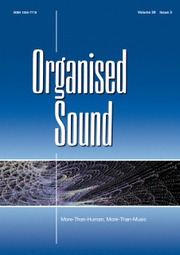Article contents
An evolutionary approach to algorithmic composition
Published online by Cambridge University Press: 11 January 2001
Abstract
This paper presents an end-user interface that allows realtime parametriccontrol of sound events resulting in an interactive environment, in whichevolutionary computation is applied to algorithmic composition. Theresulting system, Vox Populi, uses genetic algorithms to generate andevaluate a sequence of chords played as MIDI data. Harmonic, tonal andvoice range fitness are used to control musical features. Based on theordering of consonance of musical intervals, the notion of approximatinga sequence of notes to its harmonically compatible note or tonal centreis used. This method employs fuzzy formalism and is posited as anoptimisation approach based on factors relevant to hearing music.
Information
- Type
- Research Article
- Information
- Copyright
- © 1999 Cambridge University Press
- 5
- Cited by

